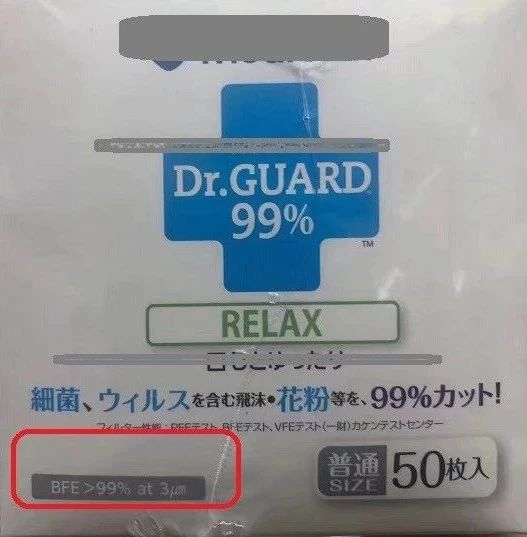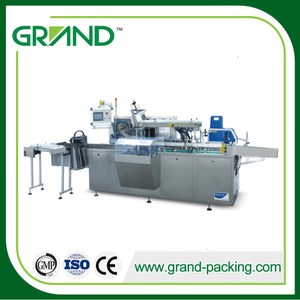
Look at the above picture, so what does BFE>99% mean?
Actually, BFE>99% is a standard targeting on particles whose size is around 0.3μm. Those masks of BFE>99% can prevent PM2.5. In other words, mask in the above picture is smog preventive.
Masks in the market can be classified into the following three types:
1) Surgical mask: Its bacteria prevention rate is 70%;
2) Respirator (N95): It can prevent 95% bacteria;
3) Ordinary cotton mask: It can only prevent 36% bacteria.
1. Why is cotton mask not useful?
Cotton mask can be used to prevent dust instead of virus. So why?
That is because, cotton mask doesn’t fit human face perfectly. Some harmful micro particles can enter respiratory tract and lungs through the crack between mask and face. Generally, a cotton mask contains some mechanical fabric. High dust-prevention efficiency can be achieved only through the increase of thickness. However, thickness increase will trouble user’s breath and make them feel sick. Therefore, if it doesn’t fit face or is not that thick, a mask cannot have expected filtration performance.
2. How about activated carbon mask?
Activated carbon is black, powdery, granule or pill, amorphous and porous. It mainly contains carbon, as well as a bit of oxygen, hydrogen, sulfur, nitrogen and chlorine. Its large surface area (500-1000m2/g) provide itself with strong absorption performance. It can absorb gas, liquid or colloidal solid onto its surface. The weight of absorbed matters can approaches to the weight of activated carbon itself.
Activated carbon mask can effectively prevent benzene, ammonia, formaldehyde, foreign smell stench and some other harmful air. Its absorption ability to gas and liquid is 30 times stronger than ordinary masks to protect human health.
Simply speaking, activated can absorb harmful gas, instead of preventing virus.
3. When are medical mask and N95 respirator used?
If we only go to the public place but won’t contact patients, medical mask can protect us well. However, N95 respirator is needed for contacting patients. Ordinary surgical mask can prevent most of virus-borne droplets. Furthermore, N95 respirator can separate smaller micro particles and fit face more firmly. However, air doesn’t circulate so that the wearer will feel suffocated. Also, N95 is more expensive. As Occupational Safety and Health Administration (OSHA) regulates, medical stuff should wear N95 respirator or respirators of higher standard, when exposed to tuberculosis.
4. Q&A
Q1: Which kind of mask is useful to prevent 2019-nCoV?
A1: Currently, surgical mask and N95 respirator are useful to prevent virus. The former one can prevent droplet and some virus, which can protect citizens from most of respiratory infections. The latter one, compared with surgical mask, is stronger to prevent virus.
Q2: Is KN95 respirator same with N95 respirator?
A2: Yes, KN95=N95. Simply speaking, KN95 is a standard of China, while N95 is a standard of foreign countries. Their prevention efficacy is the same. Besides, not only respirator of 3M is OK, but respirators bought in formal pharmacy or mall are useful, too.
Q3: Can KN90 mask replace KN95 when KN95 is unavailable? How about activated carbon mask?
A3: KN95 respirator should be our first choice. However, when KN95 is not available, KN90 is our second best choice. It can also prevent droplets and virus. However, activated carbon can only absorb some harmful gas, such as formaldehyde. It cannot be used to prevent virus.
Q4: Can KN95 be used repeatedly?
A4: Both surgical mask and KN95 respirator are suggested to be disposable to prevent 2019-nCoV. Actually, mask changing period is related to using place, time and contacting group, etc.. If mask is broken or polluted by droplets, change it timely.
Q5: Is wearing mask in multiple layers better?
A5: It is not suggested to wear mask in multiple layers. Mask prevention performance depends on its type. For example, surgical mask and N95 respirator mentioned above can have better effect. What’s more, wearing masks in multiple layers will influence breathing.
5. Mask wearing
Both mask size and wearing method influence mask performance. Mask shape can be classified into rectangle and cup.
We might be confused on which side of light blue medical mask is up?
Take disposable mask as an example, the side of darker color is facade and should be up, while the other side is lighter and should be toward our face.
In addition, a mask has a metal strip, which is the upper edge of masks.
The last step, which is also the most important step, is to press the metal strip to make the upper edge of mask be close to bridge of the nose and then to stretch mask down for no wrinkle of the mask and better covering nose and mouth.
Kids can wear these rectangular masks, because they have no fixed shape. If worn well, the mask can fit kids’ faces closely.
A. Rectangular mask wearing steps:A. Covering nose and mouth, and hanging two laces onto ears;
B. Pressing nose strip along nose bridge to prevent dirty air from entering;
C. Stretching mask down to jaw and forming a space for breathing.
2) Cup mask
Cup mask can be classified into headloop mask and earloop mask, depending on wearing method.
Cup mask can be effective only when it fits face completely and no exhaled air will leak. When wearing cup mask, the wearer can bend and close fingers and put two hand at two sides of the mask respectively. Then the wearer can take a deep breath to check whether air leaks from mask margin. If not worn firmly, the mask should be adjusted and worn again. During the process, some other head movements should be done for cooperation.
After wearing mask, the wear does not touch nose, mouth and eyes with polluted hands.
It is convenient to wear earloop masks. However, long time wearing will make someone feel pain in ear. Therefore, wearers can choose headloop masks for long time use.
A. Wearing steps for earloop masks:
a. Mask side without nose strip is toward face. The wearer can pull each ear belt and make the edge with nose strip the upper edge;
b. Jam mask into chin;
c. Hang ear belts on ears and adjust them until the wearer feels comfortable;
d. Put fingers at the medium of nose strip, press it insides and move fingers toward two sides, until the nose strip was pressed into the shape of nose bridge. One hand movement will influence mask sealing.

B. Wearing steps for headloop mask:
a. Mask side without nose strip is toward face. The wearer can pull each ear belt and make the edge with nose strip the upper edge;
b. Jam mask into chin;
c. Hang belts on heads and adjust them until the wearer feels comfortable;
d. Put fingers at the medium of nose strip, press it insides and move fingers toward two sides, until the nose strip was pressed into the shape of nose bridge. One hand movement will influence mask sealing.

6. Wearing time
From the perspective of human physiological structure, blood in human nasal mucosa circulates strongly. Nasal cavity is zigzag. Nose hair is another barrier, too. When air is inhaled, airflow will form a vortex in zigzag nasal cavity and its temperature increases as a result. Some test shows that the cold air at -7°C can reach lung with its temperature being increased to 28.8°C, which is a temperature close to body temperature. However, long-term mask wearing will weaken nasal mucosa. Nasal cavity might also lose its original physiological functions. Therefore, mask cannot be worn for a long time.
Besides, someone might have dyspnea due to chronic heart disease or lung disease. They should consult doctor about time of mask wearing.
7. Mask changing
1) When mask is polluted by blood stain or droplets;
2) When users feel resistant in breathing;
3) When mask is damaged;
4) When users wear dust mask and feel resistant in breathing. This situation indicates that the mask has absorbed too much dust and should be changed.
8. Multiple choice
After reading the above content, answer the following question and test yourself:
What is wrong while wearing surgical mask:
A. Cover nose and mouth carefully and firmly, and narrow the gap between face and mask as much as possible.
B. Wash hands with soap and water or alcohol hand sanitizer after touching mask used.
C. Dry wetted mask and use it continuously.
D. Discard disposable mask right after usage.

 English
English





